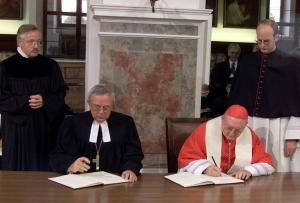Issue Date: September 12, 2003
By JOHN L. ALLEN JR. Roman Catholicism today is grappling with debates over decentralization, groping towards a collegial structure able to respect local diversity. Meanwhile Lutherans are pondering precisely the opposite question -- whether, and how, they should act more like one church and less like autonomous local fiefdoms. The coincidence invites an ecumenical dream: Could these two branches of the divided Christian family meet in the middle? The Vatican official responsible for the Catholic-Lutheran dialogue, in an exclusive interview with NCR, said he thinks they just might. Fr. Matthias Türk, a German who staffs the Lutheran desk in the Pontifical Council for Promoting Christian Unity, the Vatican office for ecumenism, pointed as evidence of convergence to the historic 1999 joint agreement on the doctrine of justification. The process that produced that document, he said, stimulated a new ecclesiastical consciousness in the Lutheran world that is bringing the two bodies closer to a common understanding of the nature of the church. The agreement was signed in Augsburg, Germany, on Reformation Sunday, Oct. 31, 1999, by representatives of the Vatican and the Lutheran World Federation. It stunned observers by declaring Catholics and Lutherans to be in “substantial agreement” on the faith/works controversy that had triggered the Protestant Reformation. “Together we confess: By grace alone, in faith in Christ’s saving work and not because of any merit on our part, we are accepted by God and receive the Holy Spirit, who renews our hearts while equipping and calling us to good works,” the key sentence reads. While the process of reaching the agreement posed doctrinal headaches for both sides, it stimulated deep ecclesiological introspection for Lutherans. “It was the first time the Lutheran World Federation had to express a doctrinal position,” Türk said. “This started a very positive development towards a more intense self-understanding, to try to bring about one worldwide communion.” Not so long ago, many Catholics doubted whether Lutherans had it in them. Cardinal Joseph Ratzinger, the Vatican’s top doctrinal official and a German with long experience of Lutheranism, once quipped: “As soon as there’s a Lutheran church, I’ll be happy to have a dialogue with it.” In fairness, it was Ratzinger who helped salvage the joint agreement, staging dramatic last-minute negotiations at his brother’s house in Regensburg, Germany (NCR, Sept. 10, 1999). Yet his comment reflected a real frustration on the Catholic side with the incapacity of the Lutheran World Federation to speak on behalf of its 136 member churches in 75 nations. While the joint agreement became official Roman Catholic policy the moment the pope approved it, every local Lutheran synod had to vote on it, leading to agonizing debates. One strongly contested issue was how many synods had to vote “yes” to put the agreement over the top. Some Lutherans thought the result should be unanimous, while others suggested a magnus consensus, or “great consensus,” would suffice. In the end, only Denmark and Madagascar turned thumbs down, and the agreement went forward. Türk said he is optimistic the Catholic church and the Lutherans may be able to sign similar joint agreements on other vexed doctrinal issues in the future, such as ecclesiology, ministry, the Eucharist and bishops. He said the most promising theme currently on the docket is koinonia, or the idea of the Christian church as communion, which creates the basis for apostolic ministry. As this work unfolds, Türk said, the Lutherans will be forging a common consciousness, fostering an appreciation for the positive aspects of Roman Catholicism’s tight vertical integration. In the exchange, he said, Catholics can also learn something from the Lutherans about how to ensure that the differing views of local churches are heard and respected. Türk said, however, that not all signs are encouraging. Today German Lutherans are debating whether to dissolve their ecclesiastical structures (the VELKD, or “United Evangelical-Lutheran Church of Germany”) and blend into the larger framework of the German Evangelical Churches, or EKD. It looks like a step towards greater unity, but Türk says such a development would “complicate dialogue” because “different theological points of view would mix.” When a draft of the Catholic-Lutheran joint agreement appeared, 120 Protestant professors in Germany signed an open letter of opposition, many from non-Lutheran traditions such as the Reformed and United churches that also make up the membership of the EKD. If German Lutherans sign up for this larger confederation, “we would have a less clear partner,” Türk said. As of the Aug. 29-31 meeting of the VELKD synod, the German Lutherans appear to have settled on a “connection model,” which would enhance their participation in the EKD but keep their structures distinct. Türk also noted that the Lutheran World Federation’s council, during its Sept. 10-17, 2002, meeting in Wittenberg, Germany, stopped short of endorsing a name change for the organization from “federation” to “communion,” preferring instead the formula, “The Lutheran World Federation: A Communion of Churches.” Though it can seem like mere wordplay, the debate reflects discomfort in some Lutheran circles with the idea of an ecclesiastical reality (“communion”) at the universal level rather than a simple administrative organ (“federation”). That does not bode well for rapprochement between Catholic and Lutheran ecclesiologies. Despite these question marks, Türk told NCR he is optimistic about the overall direction of the dialogue. “The hope is that we will understand our still different traditions as witnesses to the one Christian tradition, rooted in Jesus and carried forward by the apostles to the present day,” Türk said. “We need to think of ourselves as different expressions of the one church of Jesus Christ through the centuries. “Variety,” Türk said, “does not have to mean opposition.” John L. Allen Jr. is NCR Rome correspondent. His e-mail address is jallen@natcath.org. National Catholic Reporter, September 12, 2003 |
